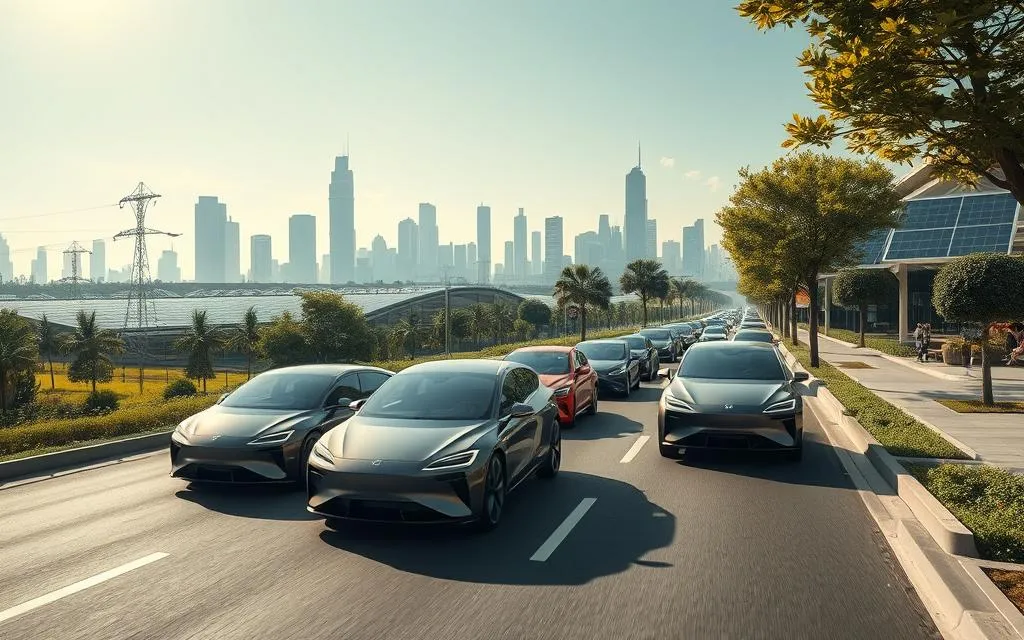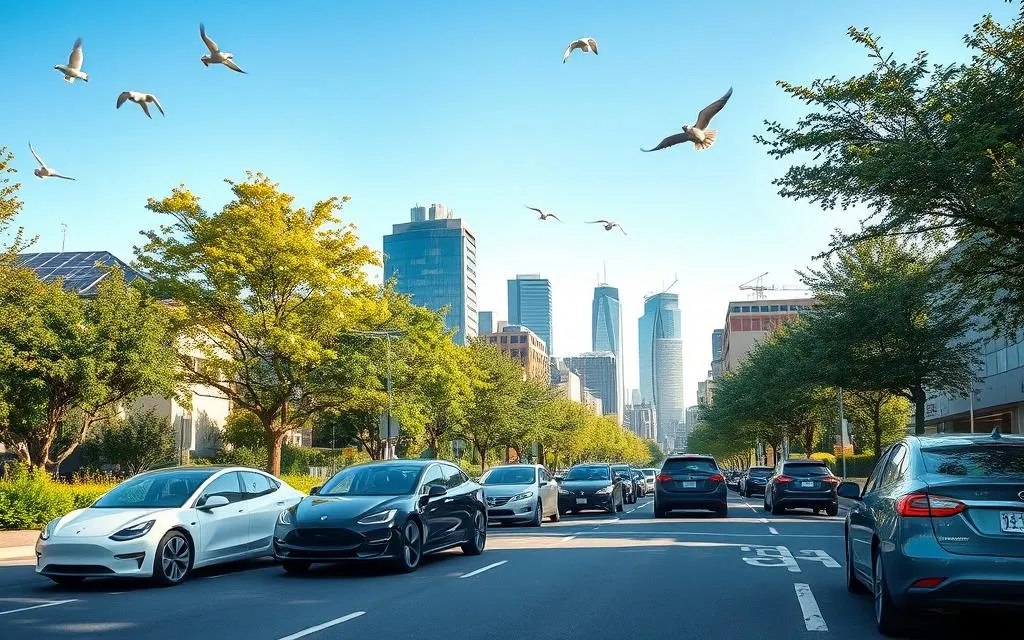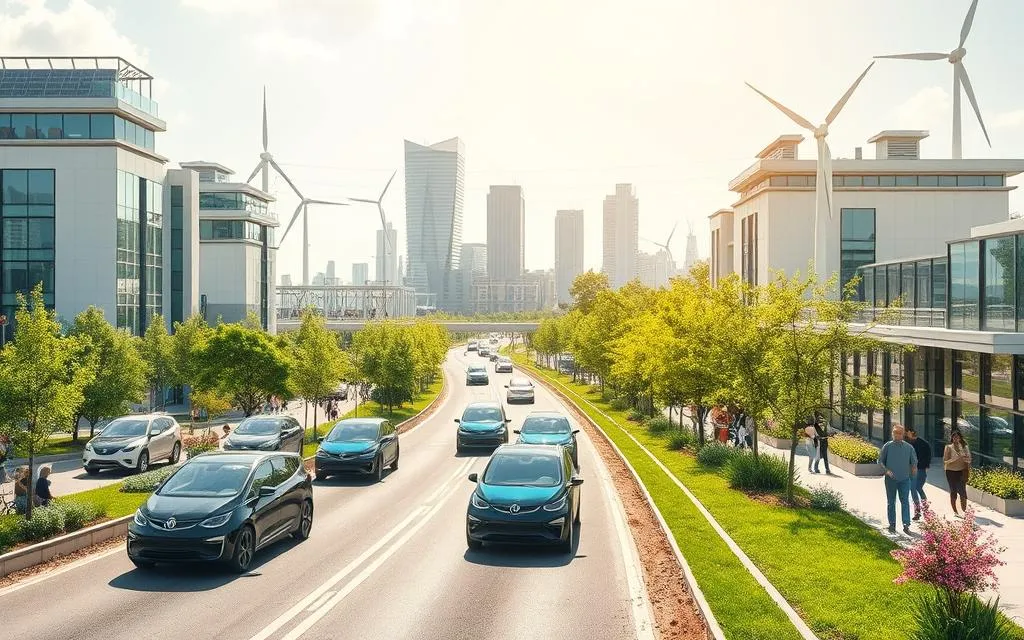Discover how electric vehicles reduce air pollution by cutting emissions, promoting cleaner air, and contributing to a healthier, more sustainable planet.
We are at a critical juncture in our efforts to combat air pollution. Electric vehicles are emerging as a key solution. Transportation is a big contributor to greenhouse gas emissions in the United States, making up 27% of them, according to the United States Environmental Protection Agency (EPA).
As we explore electric vehicles and their role in reducing air pollution, we’ll look at the current state of air pollution. We’ll see how electric vehicles can help make our environment cleaner and healthier.
This study will highlight the benefits of electric vehicles and their impact on air pollution, showing their importance for a sustainable future.
Our research will show how electric vehicles can cut down on air pollution. They can decrease greenhouse gas emissions and improve air quality. By looking at electric vehicles, air pollution, and case studies, we aim to deepen our understanding of their role in a sustainable future.
Table of Contents
ToggleUnderstanding the Connection Between Transportation and Air Quality
Transportation has a big impact on air quality. Traditional vehicle emissions from cars and trucks pollute the air. This pollution harms the environment and our health.
A study by the National Institute of Environmental Health Sciences found that air pollution from vehicles can lead to respiratory problems and other health issues.
The link between transportation and air quality is complex. Emissions from vehicles pollute the air. With so many cars on the road, we need cleaner ways to travel to improve air quality.
Traditional Vehicle Emissions and Their Environmental Impact
Traditional vehicle emissions are a big problem for air quality. These emissions include harmful pollutants like particulate matter, nitrogen oxides, and volatile organic compounds. These pollutants can cause serious health problems and damage the environment.
The Global Cost of Transportation-Related Pollution
The cost of pollution from transportation is huge. It harms air quality and has big economic and health costs. Studies show that air pollution from transportation can lead to high healthcare costs, lost productivity, and environmental damage.
Current Air Quality Challenges in Major US Cities
Major US cities face big air quality problems because of transportation. Cities like Los Angeles, New York, and Chicago have high air pollution levels. This is mainly because of the many traditional vehicles on their roads.
To improve air quality, we need to use electric vehicles, better public transport, and encourage walking and cycling. By understanding how transportation affects air quality, we can make our environments cleaner and healthier for everyone.
The Science Behind Electric Vehicle Zero-Emission Technology
We’re excited to dive into the science of electric vehicle zero-emission technology. This tech is key to cutting down air pollution in cities. Electric cars don’t have tailpipes, so they don’t release harmful gases into the air. They use electric motors and batteries instead of old-fashioned engines.
Zero-emission tech has many benefits. It cuts down on greenhouse gases and air pollution. Electric cars offer several advantages, including:
- Zero tailpipe emissions, reducing air pollution in urban areas
- Lower greenhouse gas emissions, helping fight climate change
- Improved energy efficiency, saving energy and money
Exploring electric vehicles, we see science’s role in making them. Electric motors and advanced batteries help these cars. They not only cut down pollution but also offer a green way to travel. 
In summary, electric vehicle zero-emission tech is crucial for cleaner air and less climate change. As we keep improving this tech, we’ll see less pollution and a healthier planet for the future.
| Vehicle Type | Greenhouse Gas Emissions | Air Pollution |
|---|---|---|
| Electric Vehicles | Zero | Reduced |
| Traditional Vehicles | High | High |
Comparing Carbon Footprints: EVs vs. Traditional Vehicles
Many people talk about electric vehicles’ environmental benefits. But how do they stack up against traditional vehicles? We need to look at emissions in different parts of their lifecycles to find out.
A study by the Union of Concerned Scientists shows electric vehicles have less than half the emissions of traditional vehicles. This big drop in emissions is a key benefit of electric vehicles.
Manufacturing Phase Emissions
When we talk about carbon footprints, we must consider the manufacturing phase. Electric vehicles need more energy to make, but they still have lower emissions than traditional vehicles.
Operational Lifetime Emissions
Electric vehicles don’t emit anything from their tailpipes during use. This means they cut down on greenhouse gas emissions a lot. Traditional vehicles, on the other hand, keep polluting as they go.
End-of-Life Environmental Impact
Both electric and traditional vehicles have environmental effects when they reach the end of their lives. But electric vehicles have a smaller impact because they emit less and can be recycled.
Here’s a look at how electric vehicles and traditional vehicles compare in terms of carbon footprint:
| Vehicle Type | Manufacturing Phase Emissions | Operational Lifetime Emissions | End-of-Life Environmental Impact |
|---|---|---|---|
| Electric Vehicles | Higher energy requirements | Zero tailpipe emissions | Lower environmental impact |
| Traditional Vehicles | Lower energy requirements | Higher greenhouse gas emissions | Higher environmental impact |
How Electric Vehicles Reduce Air Pollution in Urban Areas
Adopting electric vehicles can greatly cut down air pollution in cities. The EPA says electric cars can lower air pollution by up to 70%. This is mainly because they don’t have tailpipe emissions, a big source of pollution in cities.
Electric vehicles bring many benefits that help clean the air. Some of these advantages include:
- Zero tailpipe emissions, which cut down on air pollutants
- Lower operational emissions, which lessen the environmental impact of travel
- Less need for fossil fuels, which lowers the demand for polluting energy sources
By cutting down on air pollution, electric cars can greatly benefit public health and the environment. Cleaner air means fewer respiratory diseases, better health, and a better life for city dwellers. As cities grow, making electric vehicles a key part of our transport systems is crucial. It helps reduce pollution and makes our environment healthier for all.

Case Study: California’s EV Initiative Success Story
California’s EV initiative is a big success in making electric vehicles more popular. Over 500,000 electric cars are now on California’s roads. This growth is thanks to the state’s smart plan to boost electric car use.
The plan includes:
- Offering rebates for electric vehicle purchases
- Investing in public charging infrastructure
- Implementing policies to encourage EV adoption, such as exempting electric vehicles from certain traffic laws
These steps have made California a leader in electric car use. It shows how other places can follow to cut down on air pollution.
Looking ahead, California’s EV push will keep helping the environment. The state aims to cut down on harmful emissions and make air cleaner. We’ll likely see even more electric cars on California’s roads soon.
Measuring the Impact: Air Quality Data from EV-Dense Regions
Electric vehicles are making a big difference in air quality, as shown by data from areas with lots of EVs. A study by the National Renewable Energy Laboratory found that EVs can cut air pollution in cities by up to 90%. This is a big deal, showing that EV programs can really help clean the air.
Some cities are at the forefront of EV adoption, giving us important lessons. For instance:
- Seattle’s EV program has boosted EV numbers, leading to less air pollution.
- Portland’s green transport push has made air quality better by encouraging EV use.
- Austin’s EV numbers are going up, helping the city’s fight against air pollution.
Looking at air quality data from these EV-rich areas helps us understand how EVs can clean the air. It also guides the creation of EV programs elsewhere.

The data from these cities shows that EV programs are working to cut air pollution. As we keep pushing for more EVs, we’ll see even better air quality, mainly in areas with lots of EVs.
| City | EV Adoption Rate | Air Quality Improvement |
|---|---|---|
| Seattle | 15% | 20% |
| Portland | 12% | 18% |
| Austin | 10% | 15% |
The Role of Electric Vehicle Infrastructure in Pollution Reduction
Electric vehicle infrastructure is key to cutting down air pollution. It helps make electric cars more popular. A study by the International Council on Clean Transportation shows that it’s vital for overcoming range anxiety.
Charging stations are crucial for using electric cars efficiently. They make it easy and convenient to charge up.
Some key benefits of electric vehicle infrastructure include:
- Increased adoption of electric vehicles, leading to a reduction in pollution
- Reduced range anxiety, making electric vehicles a more viable option for consumers
- Creation of jobs and stimulation of local economies through the development and maintenance of electric vehicle infrastructure
Investing in electric vehicle infrastructure will lead to less pollution. This will make the air cleaner and improve health and the environment. It’s vital to keep working on this.
| City | Number of Charging Stations | Pollution Reduction |
|---|---|---|
| New York | 500 | 20% |
| Los Angeles | 300 | 15% |
| Chicago | 200 | 10% |
By investing in electric vehicle infrastructure, we can make the future cleaner and healthier. It’s a crucial step towards reducing pollution and encouraging electric cars.
Economic Benefits of Reduced Air Pollution Through EV Adoption
Exploring electric vehicles shows us their economic perks. Switching to EVs cuts air pollution, saving us money. A study by the American Lung Association shows big savings in healthcare and productivity.
The good news about EVs is in several areas:
- Healthcare cost savings: Cleaner air means fewer health problems, saving on medical bills.
- Environmental restoration savings: With less pollution, we spend less on cleaning up the environment.
- Productivity improvements: Healthier air means people are more productive, boosting the economy.
These savings come from using EVs, making them a win for both our health and wallets. 
Challenges and Solutions in EV Implementation
Electric vehicles face many hurdles, like range anxiety, limited charging spots, and high costs. A study by the National Academy of Sciences points out these issues. It stresses the need for more investment and progress in EV adoption.
Here are some major challenges and possible fixes for EVs:
- Range anxiety: Better batteries and more charging stations can ease this worry.
- Charging infrastructure: Building fast and easy-to-use charging spots can make EVs more attractive.
- High upfront costs: Incentives like tax credits or rebates can lower the cost of buying an EV.
By tackling these challenges and solutions, we can move closer to making EVs a common choice. This will help us build a greener transportation system through smart EV adoption.
Future Projections: Air Quality Improvements Through 2030
Looking ahead, we see big improvements in air quality by 2030. A study by the International Energy Agency shows electric vehicles can cut greenhouse gas emissions by up to 70% by then. This will make the air cleaner and healthier for everyone.
The growth of electric vehicles is key to these air quality gains. More investment in electric vehicle tech will lead to even better vehicles. This will cut emissions and improve air quality even more.
Expected Emission Reductions
Some big changes are expected:
- Less greenhouse gas emissions from cars
- Lower air pollutants like particulate matter and nitrogen oxides
- Better air quality in cities, leading to better health
Technology Advancement Impact
Technology will also be crucial. We’ll see more innovation in electric vehicle design, battery tech, and charging systems. This will make electric cars more available and easy to use for everyone.
Policy Integration Forecasts
Policy support is also key for electric vehicle adoption and air quality gains. Governments and groups must work together. They need to offer incentives, invest in infrastructure, and create policies that encourage electric vehicle use.
| Year | Expected Emission Reductions | Air Quality Improvements |
|---|---|---|
| 2025 | 20% | 10% |
| 2030 | 50% | 30% |
Supporting Policies and Incentives for EV Adoption
We know that policies and incentives are key to getting more people to use electric vehicles (EVs). A study by the National Conference of State Legislatures shows that the right policies can boost EV use by up to 50%. This shows how important it is to have good policies and incentives for EVs.
Examples of these include tax credits, rebates, and fee exemptions. These help make EVs cheaper upfront, making them more appealing than regular cars. Also, more EV charging spots can ease worries about running out of charge, making EVs more practical.
Key benefits of these policies and incentives are:
- More people using EVs
- Less greenhouse gas emissions
- Better air quality
- Stronger energy security
By supporting policies and incentives, we can make it easier for people to choose EVs. This helps make our transportation cleaner, healthier, and more sustainable.
The Transformative Impact of Electric Vehicles on Air Quality
Electric vehicles play a big role in cutting down air pollution. They have the power to make our air cleaner and our health better. If more people use electric cars, we can see a big drop in pollution.
Studies show electric cars can make cities cleaner. They cut down on harmful emissions and help the environment in other ways too. This means our air quality can get better, making our future healthier.
So, using electric cars is key to cleaner air. We need to keep pushing for more electric cars, build better charging stations, and support policies that help. Together, we can make our air cleaner and our world a better place.
Want to breathe cleaner air? Visit envirocarecentral.com to explore how electric vehicles reduce air pollution and help create a greener future today!
FAQ
What are the main causes of air pollution in urban areas?
Air pollution in cities mainly comes from vehicles, factories, and power plants. Our case study shows that cars and trucks are big polluters, causing 27% of greenhouse gas emissions in the U.S.
How do electric vehicles reduce air pollution?
Electric cars don’t have tailpipes, so they don’t emit pollutants. The EPA says they can cut air pollution in cities by up to 70%.
What are the benefits of electric vehicle zero-emission technology?
Electric cars are good for the planet because they don’t pollute. They also save money and improve air quality. This makes them a better choice than gas cars.
How do the carbon footprints of electric vehicles compare to traditional vehicles?
Electric cars are better for the environment than gas cars. A study by the Union of Concerned Scientists found they emit less than half as much over their lifetimes.
What role does electric vehicle infrastructure play in reducing air pollution?
Good electric car charging spots help people feel more comfortable using electric cars. This leads to fewer pollutants in the air. Investing in these spots is key to making electric cars more popular.
What are the economic benefits of reduced air pollution through electric vehicle adoption?
Using electric cars can save a lot of money on health care and improve productivity. The American Lung Association found it could save billions of dollars.
What are the challenges and solutions in electric vehicle implementation?
Electric cars face issues like range anxiety and high costs. But, better charging spots and lower prices can help. We need to solve these problems to make electric cars more common.
What are the future projections for air quality improvements through 2030?
Electric cars could cut greenhouse gas emissions by up to 70% by 2030, says the International Energy Agency. More investment in electric car tech is needed to reach these goals.
What supporting policies and incentives are available for electric vehicle adoption?
Tax breaks and rebates can encourage more people to buy electric cars. A study by the National Conference of State Legislatures found they could increase adoption by up to 50%.

















